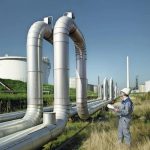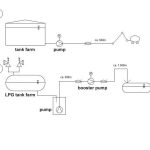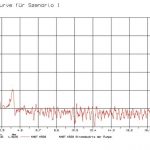Dynamic pressure fluctuations are basically unavoidable in systems carrying liquids or liquefied gases. However, these pressure surges have to be maintained within the maximal allowable mechanical design limits for pumps and piping systems, as otherwise damage can occur. Two simple examples illustrate how pressure fluctuations resulting from pump failure can be investigated and potentially eliminated.
Authors Harald Biecker Head of Process Engineering and Plant Safety, Voith Industrial Services Melanie Ruppert Project Engineer Process Engineering, Voith Industrial Services
When fluids are pumped and decanted, dynamic pressure fluctuations occur as a result of abrupt changes in flow rates. These changes in pressure are also known as pressure surges and may take the form of an increase or lowering of the pressure in the system. Frequent causes of transient flow states and the resulting pres-sure surges are:
- Switching-off of a pump (e. g. manually)
- Start-up of a pump
- Parallel operation or series installation with various pumps being switched on and off
- Unintended switching-off of a pump (e. g. due to overfilling of a tank)
As long as the pressure surges occur within the allowable mechanical design limits of the components, they do not constitute a problem. However, serious damage can occur if these design limits are exceeded. Yet this kind of dam-age is not always immediately visible and is often only detected much later. For example, damage can occur to pump foundations or pipe anchor points due to repeated pressure surges over a long period. Moreover, damage to pump impellers, bearings and flanged connections cannot be ruled out.
Options for analysing pressure surges
Some plant operators and designers use the Joukowsky equation to analyse pressure surges within their safety assessments. However, the Joukowsky equation can only be employed to obtain a simple arithmetical estimation. Its scope of application is limited and it should only be utilised in the following cases:
- Valve closing or opening times that are less than the pipe reflection times
- Periods that are within the flow rate change
- Piping with friction ratios that are within the usual range for water transport
It is also not always a matter of taking a conservative approach. Since using the Joukowsky equation only allows a rough estimation, a dynamic calculation with simulation software should be performed to obtain more accurate and reliable results.
As part of a dynamic pressure surge analysis, the system being reviewed is initially represented as a stationary node model, allowing the flow rate in the system to be analysed, for example.
To allow a holistic analysis it is necessary to know about the plant technology as well as the process and the way it works, especially the key operating and failure scenarios. This includes not just current flow and piping diagrams but also the characteristic curve of the installed actuators and the technical specifications of the equipment, piping and above all pumps.
Apart from process engineering know-how and familiarity with the possible failure sce- narios, longstanding experience in the use of the software, a systematic approach and a readily understandable mapping of the as-built status in the model are prerequisites for obtaining useful calculation results. On the basis of these results, suitable countermeasures can then be taken and damage avoided.
Various failure scenarios
Two different examples illustrate the effect of pressure surges following the failure of centrifugal pumps as well as the possible countermeasures. In the first example (Fig. 1, sce-nario 1), a fuel from an end product tank farm is being pumped to a loading terminal 500 m away. In ongoing discharge operation there is a sudden pump failure when the tank is at a very low level. The simulation shows that macro-cavitation occurs due to the mass inertia of the liquid column on the pump delivery side and the relatively low inertia of the centrifugal pump used here (Fig. 2). In the process, a cavity occurs downstream of the pump due to the loss of the liquid column. When the liquid starts to flow again, this cavity is filled suddenly and the high pressures that ensue can cause damage on the pump delivery side.
The second example (Fig. 1, scenario 2) looks at the failure of pumps installed in series. In this case a canned motor pump is being used to withdraw liquefied propylene from a tank and transfer it through a pipeline to a second tank. There is another centrifugal pump in the pipeline for boosting pressure about 500 m downstream of the discharge pump. Two failure scenarios were simulated for this example. In the first, the discharge pump on the tank fails while the booster pump remains in operation. The simulation shows that here, too, macro-cavitation occurs downstream of the discharge pump as described above. In addition, the fail-ure of the discharge pump leads to cavitation effects on the intake side of the booster pump.
In a situation where the booster pump fails and the discharge pump continues to operate, macro-cavitation is also observed downstream of the booster pump.
These examples demonstrate that the failure of pumps is a factor that must be taken into account when analysing the safety of piping systems in respect of pressure surges. The usual measures to minimise such surges include pressure chambers, surge tanks and accumulators or extending the running-down time of pump impellers by means of flywheels. The actual solution chosen has to be considered and evaluated individually for each piping system.
cpp-net.com/0214429
Experience and know-how through specific industry focus
Overview of our services
The range of services offered by Voith extends from the planning and realisation of industrial plants through on-site service to carrying out turnarounds and overhauls for petrochemical and chemical plants, refineries and power plants. As well as conventional engineering, Voith offers special engineering services like safety analyses, process simulations, the up-scaling of industrial process technologies and performing dynamic pres-sure surge simulations. The aim is to eliminate bottlenecks and help improve plant availability thanks to more stable processes.
For modernisation, optimisation or new construction projects, our experts in process engineering, plant safety, facility planning, design, process equipment and component construction and automation work in interdisciplinary teams to develop customised solutions for process plants and supply systems such as tank farms, cooling water and refrigeration systems. Voith Industrial Services therefore offers a complete service from conceptual engineering through all project phases to on-site commissioning.
Voith Industrial Services, a corporate division of Voith GmbH, provides technical services for key industries. As a leading service provider with around 20,000 employees at more than 170 locations worldwide, the company had a revenue of 1.2 billion euros in the finacial year 2012/2013.
Share:









